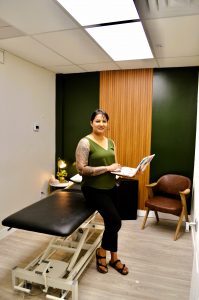
Giving Back to Our Community: Supporting Local Youth Baseball
29th September 2025
Effectiveness of Shoulder exercises
 shoulder specific and non specific exercises has shown that the focus on the combination of rotator cuff and scapular exercise program can lead to a pain-free shoulder for 52 weeks.1
shoulder specific and non specific exercises has shown that the focus on the combination of rotator cuff and scapular exercise program can lead to a pain-free shoulder for 52 weeks.1These techniques help reduce pain and inflammation, making it easier for patients to engage in physical therapy exercises that promote recovery and mobility.
1: Pulleys, Stick exercises, Active assisted exercises.
2: Resistance band
3: TENS unit (Transcutaneous Electrical Stimulation Unit)
4: Foam rollers
5: Heat or Cold packs

Shoulder Pulley
1: Shoulder Pulley– Shoulder injuries often require some form of immobilization, which restricts the Activities of daily living. Active movements like forward flexion are encouraged as soon as the tolerance allows. The rope and pulley system has been found to elicit greater rotator cuff and deltoid activation5.
The pulley systems are made so that they can be hinged over a doorway at the home, and the action to assist the injured side by guiding with the uninjured side is performed. Achieving tolerable and maximum flexion is encouraged while avoiding pulling hard or making sudden, traumatic movements.
The exercise can be performed for 2-4 minutes at a time, 2-5 times per day, or as directed by your physical therapist.

Self-Assisted Flexion
2: Self-Assisted Flexion– The self-assisted flexion, or moving the arm above your head, can be performed by lying supine on the table. Either grab the injured arm with the uninjured arm and interlock the fingers. Gently guide the arm up and perform maximum flexion the shoulder allows without aggravation of the symptoms.
Mild discomfort is expected. The movement can also be performed by holding a dowel/ light broomstick in the hand. The exercise can be performed for 2-4 minutes at a time, 2-5 times per day, or as directed by your physical therapist.
3:Table Slide: Sitting by the side of the table on a chair, grab the arm as above and interlock the fingers, gently lean trunk forward sliding both forearms over the table until reaching his/her maximum tolerable flexion. The exercise can be performed for 2-4 minutes at a time, 2-5 times per day, or as directed by your physical therapist.
4: Pendulum Exercises: Find a bed/support to lean on that is comfortable on your back. Relax the arm on the painful side, letting it hang straight down. Slowly begin to swing the

Shoulder pendulum exercises
relaxed arm. Slowly begin to swing the relaxed arm. Move it in a small circle, gradually making it bigger if you can. Then reverse the direction. Next, move it backward and forward. Finally, move it side to side.
The exercise can be performed for 2-4 minutes at a time, 2-5 times per day, or as directed by your physical therapist.
Let’s get going now!! Do the Home exercise plan. if you still have questions come and see me. We can chat, learn, and assess the shoulder pain further and provide you with valuable educational resources and help resolve the pain with the effective Physiotherapy techniques. Call 604-533-1819 or book today online
References
1: Silveira A, Lima C, Beaupre L, Chepeha J, Jones A. Shoulder-specific exercise therapy is effective in reducing chronic shoulder pain: A network meta-analysis. PLoSOne. 2024 Apr 29;19(4):e0294014. doi: 10.1371/journal.pone.0294014. PMID:38683828; PMCID: PMC11057978. https://pubmed.ncbi.nlm.nih.gov/38683828/
4: Y.H.J.M. Karela,b∗, G.G.M. Scholten-Peetersa,d, M. Thoomes-de Graafa,b, E.Duijnc, J.B. van Broekhovene, B.W. Koesb, A.P. Verhagen-Physiotherapy for patients
with shoulder pain in primary care: a descriptive study of diagnostic- and therapeutic management dx.doi.org/10.1016/j.physio.2016.11.003 https://pubmed.ncbi.nlm.nih.gov/28801032/
5: Rabin A, Maman E, Dolkart O, Kazum E, Kozol Z, Uhl TL, Chechik O. Regaining motion among patients with shoulder pathology – are all exercises equal? Shoulder 17 Elbow. 2023 Feb;15(1):105-112. doi: 10.1177/17585732211067161. Epub 2021 Dec 21. PMID: 36895611; PMCID: PMC9990106. https://pubmed.ncbi.nlm.nih.gov/36895611/

Meenie
Physiotherapist